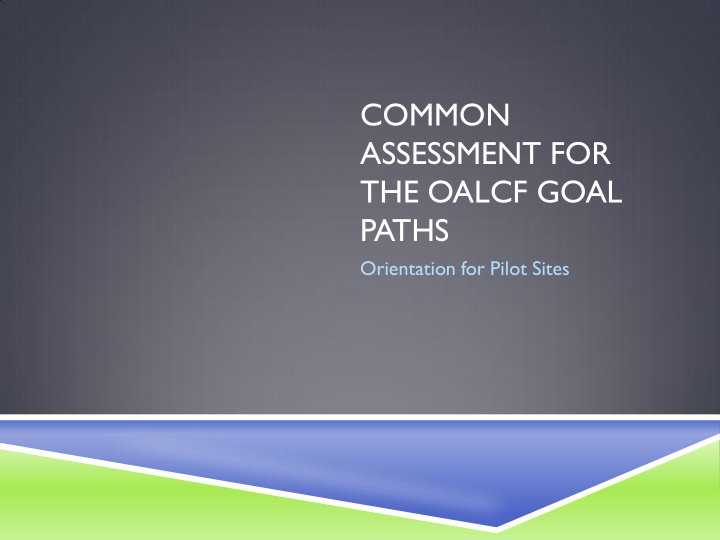



COMMON ASSESSMENT FOR THE OALCF GOAL PATHS Orientation for Pilot Sites
WELCOME & INTRODUCTIONS Project Team: Project Co-coordinators - Wendy Olson & Sandra Altenburg Project Assistant – Dorothy Daw Project Partners: Coalition ontarienne de formation des adultes Literacy Northwest Literacy Network Northeast Mid North Network
INTRODUCTIONS Project Advisory Committee Denyse De Bernardi, Le centre de formation du Nipissing Daniel Girouard, Centre d'éducation Alternative Teena Bates Yorkie, Northern College Lisa Houston, North Algoma Literacy Coalition Kaitlin Taylor, Literacy Network Northeast Jaime Lafond, Mid North Network Annemarie Wesolowski, Literacy Northwest Michel Robillard, Coalition ontarienne de formation des adultes(COFA )
OUR GOALS FOR TODAY Goal 1 - Review Pilot Site Materials : Backgrounder Letter Evaluations Confirm resources and materials received Goal 2 - Review the Introduction: Background & rational for project How the resource is organized & a short description each tool Goal 3 - Review the Goal Path resource & tools Index of Activities Key Development Skills Activity Cover Page
COMMON ASSESSMENT FOR THE OALCF GOAL PATHS RESOURCE PACKAGE I ntroduction Provides the background and rationale for the project Task-Based – skills based assessment Provides a short description of each tool/resource and suggestions for possible application Organization of the resources OALCF alignment Project icons
DRAFT COMMON ASSESSMENT STRATEGY, PART 1 Sample of a written formalized assessment strategy. Part 1: outlines what tools are used, when they should be used and for what purpose and how this resource can be incorporated into current practices Application: agencies can demonstrate capacity to select & use appropriate task-based activities Agencies can revise strategy to fit their needs
DRAFT COMMON ASSESSMENT STRATEGY, PART 2 Provides suggestions on how to use assessment results and data reports to inform decisions regarding assessment, goal path projections & provides a common approach to reporting Application: Agencies can use this tool to inform practitioners, and other agency staff/members of data results
TASK BASED ASSESSMENT, MILESTONE & CULMINATING TASK TRACKING SHEET Practitioner tool to track and easily identify what task-based assessment has been done and/or completed Application: File documentation Visual reference to share with learner and MTCU ETC Provides evidence that task-based assessment is being completed
BLANK TASK TEMPLATE Practitioners can use to develop their own tasks
GOAL PATH RESOURCES: INDEX Listing of all the activities for each Competency, by task group and level
GOAL PATH RESOURCES: KEY DEVELOPMENT SKILLS CHECK LIST Adapted from MTCU Goal Path Descriptors Aligned to the OALCF framework Application: Share with learner when discussing goal path requirements Check off skills/tasks the learner can do Can be used as a tool to inform assessment and learner plan activities
GOAL PATH RESOURCES: ACTIVITIES – COVER PAGE Activity title & task group Performance descriptors Embedded skills/knowledge Additional sample tasks Practitioners Notes Task Completion Acknowledgment box Each activity includes instructions and answer sheets. Those that do not are online activities
ANSWER SHEETS & RESOURCE LISTS Each goal path resource includes: Answer sheets - back of the activities Resource List – Print based /web based includes links
COMMON ASSESSMENT FOR THE OALCF GOAL PATHS RESOURCE PACKAGE How does this resource align with the OALCF? Fair Assessment Principles Task-based assessment for all five goal paths All activities are aligned to the OALCF and build readiness for milestone completion Activities, language and tools are clear and appropriate for all levels Provides a consistent approach to assessment practices T ools within the resources are consistent and user friendly
COMMON ASSESSMENT FOR THE OALCF GOAL PATHS RESOURCE PACKAGE How can agencies use this resource to report to MTCU? Site Compliance Visit Self-Assessment Questionnaire (pg 2 & pg 3) “Describe the assessment strategies/tools you use with Clients and Learners to determine: eligibility, learning style, assessment, and learning activities” The Common Assessment for the OALCF Goal Paths Resource provides agencies with a sample common strategy and tools that practitioners can use to select, administer, interpret and track assessment results “ Describe how your learner plans are developed and how you ensure they capture the following” Resources that are aligned with the OALCF and provides practitioners with task- based assessment activities, tracking sheets provide detailed progress
QUESTIONS & FEEDBACK Thank you for your participation today Questions, concerns
Recommend
More recommend